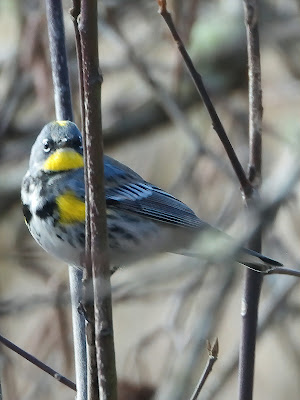Coyotes are abundant across most of North America and are increasingly found even in urban areas. These images were taken at the same location, and thus could be of the same individual, on 7 February 2022 and 9 March 2022 at the Billy Frank Jr National Wildlife Refuge. The Coyotes seemed relatively unconcerned about our presence, potentially indicating sick animals, but more likely the result of their not being hunted on the refuge. The animals appeared to be searching gopher burrows. We have seen a Coyote run across our driveway within the Olympia city limits and we often hear their wailing at night.
Monday, March 21, 2022
Saturday, March 19, 2022
Common Teal 2
On 15 March 2022, Erika and I found another of the European race of the Green-winged Teal. It foraged in almost exactly the same location at the bird we saw several weeks ago at the Nisqually National Wildlife Refuge, on 1 March 2022. This duck lacks the white, vertical side-stripe of American Green-winged Teal but does not appear to be the same individual that previously observed. The pale facial lines do not seem to be as distinct. Also, the horizontal, white body stripe is more apparent.
Friday, March 18, 2022
Wood Duck
A Wood Duck pair—this time at the McLane Creek Nature Trail on 10 March 2022. In the early 1900s, ornithologists believed the species might be heading towards extinction. According to Hepp and Belrose (2020), Wood Duck populations are increasing by about 2.5% yearly as a result of bag limits during hunting season. Habitat management and nest box programs also assist the Wood Duck population recovery from historic lows.
Wednesday, March 16, 2022
Mourning Dove
On 15 March 2022, along a path through the riparian woodland in the Billy Frank Jr National Wildlife Refuge, Erika and I photographed a Mourning Dove collecting sticks. We see this species often enough in Olympia, but this dove does not seem as common as elsewhere in the country. Mourning Dove nests are notoriously poorly constructed—usually just a bunch to sticks piled together in a tree or bush. The twigs this individual collected seemed remarkably thin, perhaps to line the interior of the nest. Males collect nesting material and bring it to the females, who do the actual nesting building, usually with the male standing on her back!
Tuesday, March 15, 2022
Ring-necked Duck
Every time we see Ring-necked Ducks, like these on 10 March 2022 at the McLane Nature Trail near Olympia, Erika rails against confusing bird names. “Why isn’t this bird named ‘Ring-billed Duck,’” she exclaims. “The birds do have ringed necks,” I patiently explain, “but the neck rings are dark brown and very hard to see.” “Harrumph,” replies Erika.
Monday, March 14, 2022
Varied Thrush
During our 10 March 2022 stroll in the Woodard Bay Natural Area near Olympia, we walked into a mixed flock of Varied Thrushes and American Robins. Although both species are thrushes and similar in size, they are not closely related. Varied Thrushes appear to be more closely related to Aztec Thrushes in Mexico or to a number of Asian species. In any event, Varied Thrushes are among our favorite birds. They are common enough in Washington but tend to be vagrants away from the Pacific Northwest. The scalloped pattern on the females’ flanks is as stunning as the males’ orange and black plumage.
Sunday, March 13, 2022
Pelagic Cormorant
At one time or another, Erika and I have listed all three local cormorants at the Woodard Bay Natural Area near Olympia. The most common are Double-crested Cormorants that breed in the hundreds in the trees along the edge of the bay. Occasionally Pelagic or less often Brandt’s cormorants are found, perched on distant pier pilings. Identification usually depends on having a scope along, like when we found this Pelagic Cormorant on 10 March 2022. The bird has its back to us and the distinctive white patches on their lower flanks are obvious.
Saturday, March 12, 2022
Bufflehead
Erika and I strolled past a hen Bufflehead on 7 February 2022 and a male on 24 February at the Billy Frank Jr National Wildlife Refuge. Buffleheads feed in shallow water. They usually dive for their invertebrate prey (fish are also consumed), but occasionally dabble on the water surface.
Friday, March 11, 2022
Yellow-rumped Warbler
Erika and I saw these Yellow-rumped Warblers on 24 February 2022 at the Billy Frank Jr National Wildlife Refuge. When we moved to Olympia, we did not expect to see both races of this bird—the white-throated Myrtle Warbler and the yellow-throated Audubon’s Warbler. We have always thought of the Myrtle Warbler as an eastern bird, while Audubon’s are western. This assumption is basically correct, but the Myrtle Warbler does breed in Alaska and northern British Columbia. Thus the two races do occur north of us here in Washington and can be expected to migrate through the state.
Although the two races interbreed in the limited areas where they overlap, ornithologists still argue if they represent one or two species. The Audubon Society writes: “Even though the white-throated Myrtle and yellow-throated Audubon’s types interbreed where they meet, they’re very distinct genetically throughout the rest of their range. The evidence suggests that each is a full species.” The American Ornithological Society’s Checklist Committee has yet to agree.
Thursday, March 10, 2022
Eurasian Wigeon
On 17 February 2022, this Eurasian Wigeon fed among some 20 American Wigeon along the dike trail at the Billy Frank Jr National Wildlife Refuge. These ducks are “fairly common winter residents” in western Washington (Wahl et al. 2005). These authors estimate that about one out of every 400 wigeons here are this species. Not known to breed in North America—birds that winter along the West Coast are assumed to have nested in eastern Asia. For unknown reasons, this duck’s population has increased since 1965.
Subscribe to:
Posts (Atom)


















